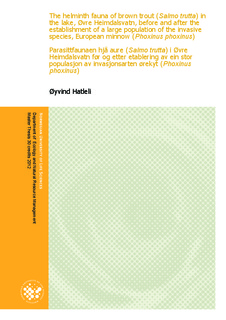| dc.description.abstract | The objective of this thesis is to compare the parasite fauna of brown trout (Salmo trutta) in the lake, Øvre Heimdalsvatn, before and after the establishment of a large population of the invasive species, the European minnow (Phoxinus phoxinus). Brown trout were collected in June, July and September of 2011, by means of gillnetting. A total of 392 fish were caught, of
which 113 fish, evenly distributed on different length-classes from 9 cm to 39 cm, were examined for parasites. A study of the helminth fauna in the lake was done in 1969-72, just after the introduction of the European minnow, while the population density of the minnow was low. By repeating the study, 40 years later, we can gain valuable information on how
introductions of the European minnow may affect the parasite fauna of brown trout in
subalpine lakes. Nine of the parasite species were the same as those found in 1969-72, while one species,
Eubothrium crassum, was not found, though another species, Diphyllobothrium dendriticum, not recorded in 1969-72 was found in 2011. The mean intensity of some species showed major changes, especially the three species Diphyllobothrium ditremum, Crepidostomum sp. and Diplostomum spathaceum, these showed great changes in abundance from 1969-72 to 2011. Many of the parasite species found in brown trout are dependent on one or several intermediate hosts, both vertebrates and invertebrates, and changes in the availability of these
will influence the success of the parasites. The increase in fish-eating birds in the lake, Øvre Heimdalsvatn, probably as a result of a large European minnow population, may also influence the transmission rates of parasites with birds as final host.
Documented changes in population dynamics of brown trout and the invertebrate community in the lake, Øvre Heimdalsvatn, has been linked to the establishment of the European
minnow, and has effectively influenced the availability of intermediate hosts. As a conclusion, the European minnow has indirectly changed the premise for many of the helminth species in the lake, thus influencing the abundance of the parasite species. The changes in the parasite
fauna of brown trout, demonstrate another effect on a subalpine lacustrine ecosystem, as a result of establishment of an invasive species, the European minnow. Bakgrunnen for denne oppgåva er å samanlikne parasittfaunaen hjå aure (Salmo trutta) i Øvre Heimdalsvatn før og etter etableringa av ein stor populasjon av invasjonsarten ørekyt (Phoxinus phoxinus). Fisken vart fanga med ein fast garnserie i juni, juli og september 2011. Totalt vart 392 fisk fanga, og 113 av dei, jamt fordelt på lengdeklassar frå 9 cm til 39 cm, vart
undersøkt for parasittar. Parasittfaunaen i vatnet er tidlegare undersøkt i 1969-72, før
populasjonen av ørekyt i vatnet var stor. Ved å gjera same undersøkinga no, 40 år etter, kan ein få nyttig informasjon om endringar i parasittfaunaen i eit høgfjellsvatn som følgje av ei etablering av ørekyt. Totalt ti parasittar vart funne i vatnet, inkludert ein ny art (Diphyllobothrium dendriticum).
Samanlikninga av den gjennomsnittlege parasittinfeksjonen i 1969-1972 mot 2011 syner store skilnadar i parasittfaunaen i vatnet. Parasittane Diphyllobothrium ditremum, Crepidostomum
sp. og Diplostomum spathaceum synte størst endring i gjennomsnittleg infeksjon. Fleire av parasittane i aure er avhengige av ein eller fleire mellomvertar for å fullføra livssyklusen sin, og ei endring i tettleiken av desse kan påverka suksessen til parasittane. Auken av fiskeetande
fugl ved vatnet, truleg på grunn av ørekyt, kan ha påverka distribusjonen av parasittar som har fugl som endeleg vert. Dei godt dokumenterte endringane i populasjonsdynamikken hjå aure og i
evertebratsamfunnet i Øvre Heimdalsvatn har vorte kopla til etableringa av ørekyt i vatnet. Dette har som ein effekt endra tilgjenge av mellomvertar. Ørekyt har indirekte endra føresetnadane for mange av parasittane og dermed også utbreiinga i vatnet. Dei store endringane i parasittfaunaen er openberre og syner endå ein effekt av invasjonsarten ørekyt. | no_NO |
